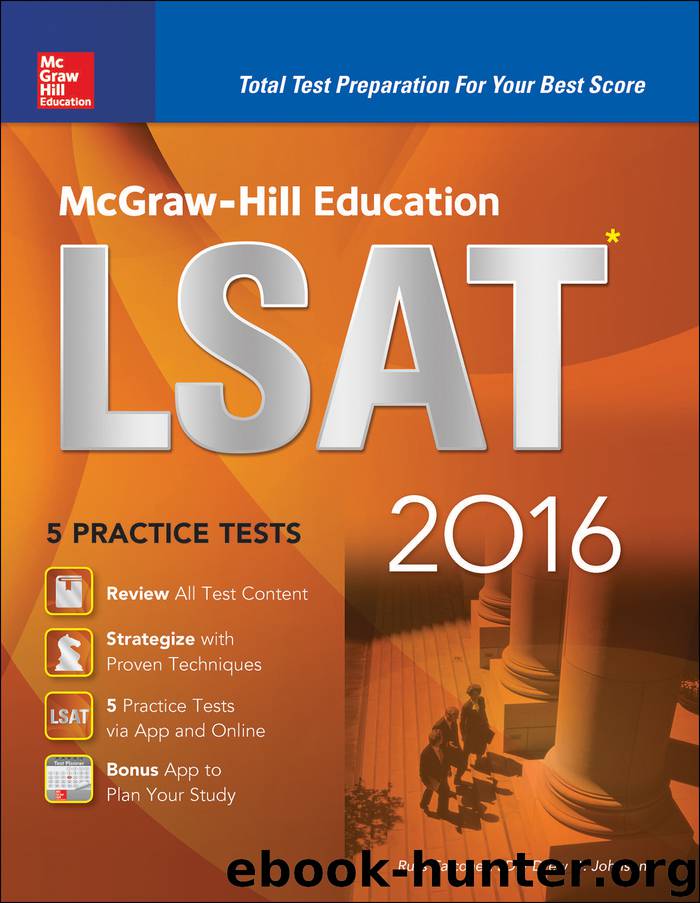McGraw-Hill Education LSAT 2016 by Russ Falconer

Author:Russ Falconer
Language: eng
Format: epub
Publisher: McGraw-Hill Education
Published: 2015-12-31T05:00:00+00:00
Practice
Read and annotate the passage that appears on the following page. Write down the summary you create in the blanks that appear at the end of the passage. Once you’re finished, compare your annotations and summary to the example that follows. Then work the practice question that appears on the following page.
SUMMARY
(1)
(2)
(3)
SUMMARY
Practice Question
It can be inferred from the passage that Cvetkovich would be most likely to agree with which one of the following statements?
(A) The core principles of traditional trauma theory include the notion that trauma engenders public culture.
(B) The diagnosis of post-traumatic stress disorder has no role to play in trauma discourse.
(C) The idea that trauma is a productive force has been accepted by a majority of the field’s most well-established critics.
(D) Michelle Tea’s novels create a cultural response to trauma that has the potential to engender political efficacy.
(E) The investigative work of Margaret Randall exemplifies the dichotomous public–private approach to understanding trauma.
Answer and Analysis. The correct answer is choice D. This is a detail-combination inference. Lines 13–17 state that Tea’s novels are part of Cvetkovich’s “archive of feelings,” and lines 45–50 state that Cvetkovich believes that each of the texts in her “archive of feelings” holds the promise of political efficacy.
Choice A directly contradicts information from the passage: lines 4–10 and 59–65 establish that the notion that trauma engenders public culture is a radical departure from traditional trauma theory. Choice B is in the right direction, but it goes too far: lines 34–39 establish that Cvetkovich wants to “resist the near-total authority” given to the diagnosis of PTSD, but the passage does not go so far as to say that medical diagnosis should play no role whatsoever in trauma theory. Choice C goes beyond the scope of the passage. The passage discusses the content of Cvetkovich’s new theory, but it does not discuss that theory’s critical reception. Finally, choice E misstates the content of the passage. The passage draws no connection between its discussions of Randall’s investigative work (line 16) and the public–private dichotomy (line 33). If anything, the statement at lines 45–50 suggests that Cvetkovich’s view of the relationship between the two would be the opposite of what’s stated in choice E.
Download
This site does not store any files on its server. We only index and link to content provided by other sites. Please contact the content providers to delete copyright contents if any and email us, we'll remove relevant links or contents immediately.
| Administration | Assessment |
| Educational Psychology | Experimental Methods |
| History | Language Experience Approach |
| Philosophy & Social Aspects | Reform & Policy |
| Research |
The Art of Coaching Workbook by Elena Aguilar(48064)
Trainspotting by Irvine Welsh(20055)
Twilight of the Idols With the Antichrist and Ecce Homo by Friedrich Nietzsche(17705)
Fangirl by Rainbow Rowell(7834)
Periodization Training for Sports by Tudor Bompa(7328)
Change Your Questions, Change Your Life by Marilee Adams(6641)
This Is How You Lose Her by Junot Diaz(5771)
Grit by Angela Duckworth(4736)
Red Sparrow by Jason Matthews(4665)
Asking the Right Questions: A Guide to Critical Thinking by M. Neil Browne & Stuart M. Keeley(4574)
Paper Towns by Green John(4169)
Room 212 by Kate Stewart(4107)
Ken Follett - World without end by Ken Follett(3972)
The Sports Rules Book by Human Kinetics(3588)
Housekeeping by Marilynne Robinson(3401)
The Motorcycle Diaries by Ernesto Che Guevara(3332)
Introduction to Kinesiology by Shirl J. Hoffman(3299)
Exercise Technique Manual for Resistance Training by National Strength & Conditioning Association(3291)
Double Down (Diary of a Wimpy Kid Book 11) by Jeff Kinney(3272)
